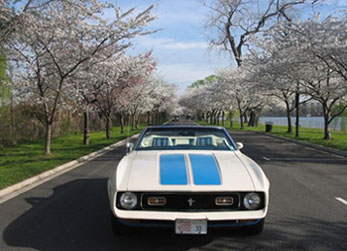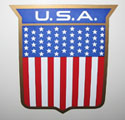National Cherry Blossom Festival License Plates
A Series of Special Event, Limited-Use Plates
 From 1962 through 1974, special sequentially-numbered license plates were issued for use on official vehicles involved in the National Cherry Blossom Festival, and they were also made available to the general public in limited quantities. In 1976 special plates were again made, but they are not numbered. No Cherry Blossom Festival plates have been made since then. Although no data is known that indicates how many of each of these plates were actually issued, numbers on surviving examples suggest that no more than a few hundred pairs of each were produced.
From 1962 through 1974, special sequentially-numbered license plates were issued for use on official vehicles involved in the National Cherry Blossom Festival, and they were also made available to the general public in limited quantities. In 1976 special plates were again made, but they are not numbered. No Cherry Blossom Festival plates have been made since then. Although no data is known that indicates how many of each of these plates were actually issued, numbers on surviving examples suggest that no more than a few hundred pairs of each were produced.
All Cherry Blossom Festival plates were issued in pairs and are 6" x 12". Those issued through 1970 are cardboard whereas the last four numbered plates, dated 1971 through 1974, are embossed aluminum.
At a meeting held during the week of March 18, 1962, members of the D.C. Board of Commissioners voted to authorize the use of “special-use identification tags, of the special Cherry Blossom variety” during the period of April 1-15. Specifically, the plates were to be made available to Cherry Blossom Festival Committee and could be displayed only on otherwise unregistered vehicles upon payment of a fee of $1 per pair. This original arrangement was intended to facilitate display of the pink cardboard plates only on cars provided by auto manufacturing companies, and possibly additional new vehicles made available by local dealers.
A week later, however, DMV Director George A. England appeared before the commissioners with Herman S. Cole, his deputy, to request a revision to the pervious decision that would allow the plates to be sold to and used by owners of registered vehicles. Presumably this change originated with the event's organizing committee to allow members of the public, not just those affiliated with the event and to whom an official "courtesy vehicle" was provided, to enjoy the use of these distinctive plates. According to a memo prepared following the commissioner's March 27 meeting, “After the Commissioners had discussed and considered some of the problems in connection with the expansion of the use of these Cherry Blossom tags, they decided that...the Cherry Blossom Festival Committee could issue tags of the same design to owners of vehicles already registered with the condition that they be affixed to the vehicle along with the regular tag during the Cherry Blossom Festival, except that the Cherry Blossom tags could be substituted for the regular tags during the period of the parade only.” This amendment to the original decision also allowed vehicles not provided by manufacturers and dealers to be used in the parade with the special plates.
Whether the commissioners received special Cherry Blossom Festival plates in 1962 is unknown, but on March 27, 1963, they were presented with plates numbered 1, 2, and 3, to match their regular D.C. registration numbers.
The exact timing of the Cherry Blossom Festival, an event sponsored by the Washington Convention and Visitors Bureau during the period that special plates were used, changes slightly every year to coincide with the period during which the famous trees are expected to be in bloom. Prior to 1966 (although 1962 seems to be an exception) the plates are thought to have been valid for periods that did not exceed ten days, in part due to the relatively short duration of the event but also because attorneys for the city had advised the Commissioners that they had the authority to authorize the issuance of special plates, such as those made for the Cherry Blossom Festival, in increments of (or up to) ten days.
On February 10, 1966, the commissioners approved the use of 1966 Cherry Blossom Festival special event plates from April 12 through 17. On February 15, however, Clarence A. Arata, executive director of the CVB, wrote to Commissioner Walter Tobriner to ask whether that period might be extended to 15 days, from April 4 through 18. “Since the Oldsmobile Company is shipping in a large quantity of cars in advance of the Festival, we would like to be able to place the tags on the cars for general Cherry Blossom promotional purposes as early as possible,” wrote Mr. Arata. The 1966 festival began on April 11 and ended on the 17th, so the committee wanted to be able to use their distinctive plates for a full week before their event began, not just one day.
Despite the recommendation of DMV Director George England that the request made by Mr. Arata on behalf of the CVB be denied, on March 8, 1966, the commissioners amended their Feb. 10 decision by extending the authorized period of use of 1966 Cherry Blossom Festival plates. Technically, the new 15-day period of validity was accomplished by the commissioners authorization of two consecutive ten-day periods during which the plates could be displayed. A mid-March memo generated by the commissioners office indicates that Dir. England had reported that “approximately 200 [pairs of] special tags are involved, of which 53 will be used by manufacturers' motor vehicles which have not as yet been registered.” These 53 cars are the Oldsmobiles mentioned in Mr. Arata's Feb. 15 letter referenced above.
A March 31, 1966, Cherry Blossom Festival memo to committee members announced the availability of the plates, indicating that they were then on sale at the CVB's office, at 1616 K. St., NW, and that they had to be registered, which is to say they apparently could not be purchased simply as souvenirs. Their cost increased to $5 for 1966, the charge being comprised of a $2 registration fee and $3 plate fee.
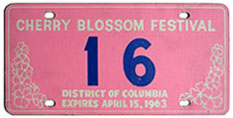
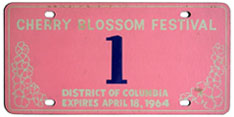
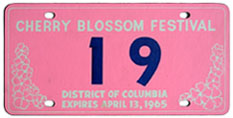
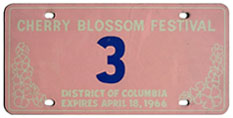
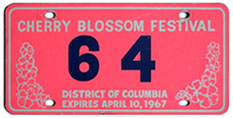
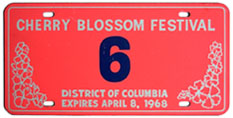
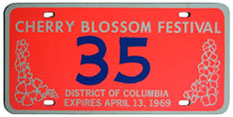
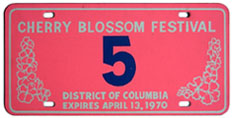

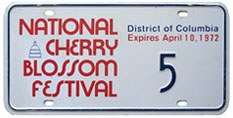

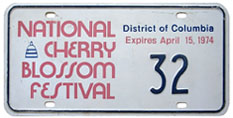
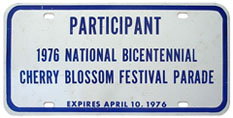
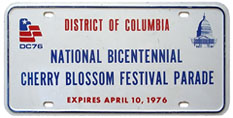
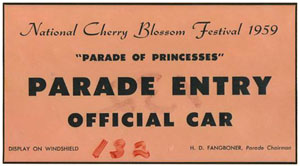 |
Prior to the issuance of special plates, during the 1950s special Cherry Blossom Festival windshield decals were produced. These 4-1/2" x 7-3/4" decals are pink with black lettering. As noted on the 1959 decal shown, they were to be used on official cars in the "Parade of Princesses." |
Washington, D.C.'s Famous Cherry Trees
and the National Cherry Blossom Festival
 Every spring, the blooming of the thousands of cherry trees around the Tidal Basin in the District of Columbia attracts hundreds of thousands of visitors to the area. More than 3,000 cherry trees were presented to the United States in 1912 by the Japanese government as a sign of friendship between the two nations. The formal donation ceremony occurred on March 27, 1912, when First Lady Helen Herron Taft, wife of Pres. William Howard Taft, and Viscountess Chinida, wife of the Japanese Ambassador to the United States, planted the first two trees on the northern side of the Tidal Basin. At the conclusion of the planting, Mrs. Taft presented a bouquet of American Beauty roses to the Viscountess.
Every spring, the blooming of the thousands of cherry trees around the Tidal Basin in the District of Columbia attracts hundreds of thousands of visitors to the area. More than 3,000 cherry trees were presented to the United States in 1912 by the Japanese government as a sign of friendship between the two nations. The formal donation ceremony occurred on March 27, 1912, when First Lady Helen Herron Taft, wife of Pres. William Howard Taft, and Viscountess Chinida, wife of the Japanese Ambassador to the United States, planted the first two trees on the northern side of the Tidal Basin. At the conclusion of the planting, Mrs. Taft presented a bouquet of American Beauty roses to the Viscountess.
 |
As has been done for many special events in Washington,
D.C. over the years, special "No Stopping or Standing" signs were produced for use during at least one past
Cherry Blossom Festival: 1974. They were posted along roadways around the
Tidal Basin in an effort to keep
motorists from stopping
to admire the cherry blossoms, thereby adding to traffic jams that occur in the area. The
cardboard sign is 11.5" x 18" and has brass grommets
for mounting on trees and telephone poles. |
The two original Yoshino cherry trees are still standing today, and bronze plaques that commemorate the original plantings are at the base of each one. Over the years, more than 400 cherry trees have been propagated from the original 1912 trees to ensure that the genetic lineage of the originals is preserved.
As a point of reference to the tree's location, the Jefferson Memorial and Franklin Roosevelt Memorial are also located on the Tidal Basin. The Basin itself is across the street from the Washington Monument, which is across the street from the White House. Within an easy walk of the Tidal Basin are the Lincoln Memorial, World War II Memorial, Korean War Memorial, Vietnam War Memorial, Holocaust Museum, and various Smithsonian Museums.
In 1934, the District of Columbia Commissioners (a three-person commission that at the time governed the District) sponsored a three-day Cherry Blossom celebration. The event was such a success that in 1935 the first “Cherry Blossom Festival” was jointly sponsored by a number of civic organizations. The festival has been held annually ever since.
During World War II the original cherry tree orchard in Japan from which the 3,000 trees destined for the United States were taken in 1912 had been destroyed or fallen into decline. Japan asked the United States for help in restoring the grove, which was situated along the Arakawa River near Tokyo. The National Park Service of the U.S. Department of the Interior responded by sending budwood from the original 3,000 cherry trees back to Japan in an effort to restore the original orchard.
Also after World War II, the Cherry Blossom Festival had expanded to include the selection of Cherry Blossom Princesses from each state and U.S. territory. The week-long festival included a parade with cars for each of the Princesses and other VIPs. In 1994, the National Cherry Blossom Festival was further expanded to two weeks.
 |
Apparently without a distinct registration certificate for Special Event plates in (at least) 1968, the DMV used a Special Use Tag form for this short-term issue. The actual size of this document, which shows that the number 39 set of 1968 Cherry Blossom Festival plates was displayed on a 1967 Chevrolet convertible, is 3-1/4" x 8-1/2 ". |
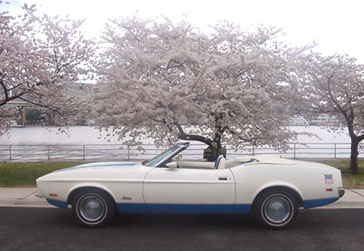 |
|
|
Among vehicles upon which special National Cherry Blossom Festival license plates were used in 1972 was a fleet of 50 special Ford Mustang convertibles provided by Ford Motor Company especially for the occasion, perhaps to commemorate the 60th anniversary of the first trees being planted. The 50 Cherry Blossom Princesses, one representing each state, rode in the vehicles during the 1972 Parade of Princesses. This beautiful example of the special 1972 Mustangs, pictured at the Tidal Basin during the Festival, belongs to Mr. Rex Turner, who is a member of the National Capital Region Mustang Club. To the left is a close-up of the decal that appears on the quarter panel. |
Charlie Gauthier, a Washington, D.C. native who now resides in Northern Virginia, is an expert on the subject of D.C. special event license plates. DCplates.com appreciates his work in preparing this page and his willingness to share his National Cherry Blossom Festival plates and related items. For more information about these special event plates or to provide more information about or images of them, please send an e-mail to Mr. Gauthier at Charlie@DCplates.com.
|
This page last updated on December 31, 2017 |
 |
|
copyright 2006-2018 Eastern Seaboard Press Information and images on this Web site may not be copied or reproduced in any manner without consent of the owner. For information, send an e-mail to admin@DCplates.net |


